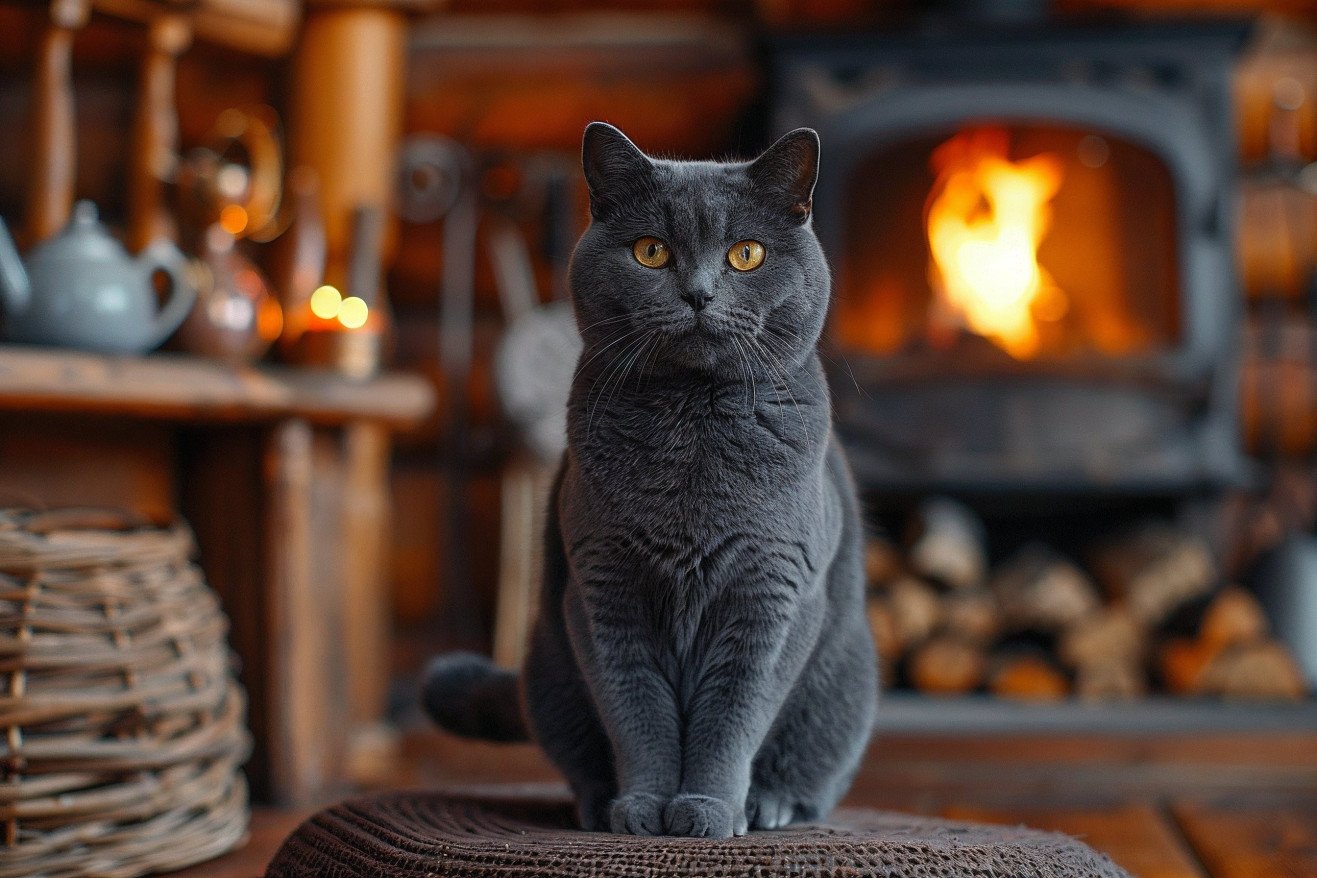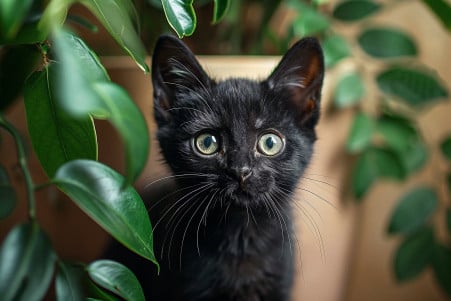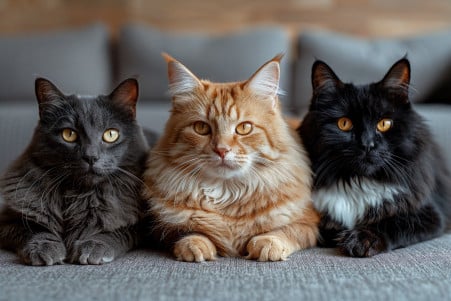How Big Do Cats Get? A Look at the Height of Different Cat Breeds
6 May 2024 • Updated 6 May 2024

If you’ve ever wondered how big your cat will get, you’re not alone. The size of a cat can depend on a number of factors including breed, age, and more. That said, the average domestic cat is about 12 inches tall, but the range of a cat’s height from the bottom of their paws to the top of their ears or head is between 8 and 16 inches.
In this article, we’ll explore the science of cat size and height, including research from a variety of fields that investigates the genetic, environmental, and biological determinants of a cat’s size. This will help us understand why certain breeds and even populations of cats tend to fall within certain height ranges, and will help us better understand our feline friends.
How tall do cats get?
Genetics, Sex, and Neutering
Genetics play a large role in a cat's final height. Some breeds, such as the larger Maine Coons and Savannahs, are more prone to growing taller, while smaller breeds like the tiny Singapura and Munchkin are more likely to remain small. According to Purina, male cats are also generally larger than females of the same breed due to hormonal and genetic reasons.
Neutering and spaying can also impact a cat's final size. As demonstrated in a study published in PMC, neutered cats are often larger than those who aren't neutered, especially if they are neutered at a younger age. However, the age at which a cat is neutered matters - the same PMC study found that cats who were neutered later in life had a smaller impact on their final size.
In addition to genetics, sex, and neutering status, other factors like diet, health issues, and individual genetics can impact a cat's final size and how they grow over time. While there are generalities, a cat's unique genetics will ultimately determine how tall they grow.
Cat Size Extremes: From the Smallest to the Tallest
The size of domestic cats varies considerably, with the smallest cat, the 3-pound Singapura, and the largest cats, the 20+ pound Maine Coon and Savannah breeds, representing the extremes. The smallest cat breeds, like the Munchkin and Devon Rex, tend to have short legs and small bodies that make them look like kittens even as adults. Meanwhile, the tallest and heaviest breeds, such as the Norwegian Forest Cat and Ragdoll, can stand more than 16 inches tall and weigh more than 25 pounds.
The heights of wild cat species also vary considerably, with the Rusty-spotted cat measuring just 13.8 inches, and extinct species like the Ngandong tiger growing to more than 13 feet long. A cat's size can impact its ability to hunt, move, and perform other physical tasks, and the smallest and largest cats both have their own unique strengths and limitations.
How to Measure a Cat's Height: Techniques and Tips
A cat's height is usually measured from the floor to the withers or shoulders, while length is measured from the base of the neck to the base of the tail. TheCatSite specifies that the most important part of the height measurement is from the floor to the shoulder. Other measurements, including neck and torso circumference, tail length, and paw size, can also help determine a cat's size and body proportions.
To ensure that measurements are consistent and accurate, it's important to use standardized measurement techniques, such as a flexible tape measure and rounding to the nearest 0.1 cm. Sparkle Cat points out that other factors, such as a cat's age, body condition, and coat length, can affect the accuracy of height and length measurements, so these factors need to be taken into account.
While measuring a cat's height and length can be helpful, especially when it comes to tracking growth, it's often recommended that a cat's overall size be assessed by weighing the cat on a scale. This is also the best way to monitor a cat's growth or weight gain over time, according to Catster.
Health Implications of Cat Size and Height
A cat's size and height can also have health implications, and there are potential risks associated with both being too tall and too small. A study published in PMC found that cats that are too tall or large may be more likely to suffer from joint problems, such as arthritis or hip dysplasia, because of the extra weight and stress placed on their skeletal system.
Meanwhile, cats that are too small or undersized may have trouble with mobility, hunting, and maintaining a healthy weight. As Dutch pointed out, cats that are extremely underweight should be taken to the vet immediately because they probably aren't getting the nutrients they need to support their bones, joints, and organs.
In addition, cats may have health issues that affect their size, such as dwarfism or gigantism, which will require special care and attention. Regular vet visits and keeping an eye on a cat's weight, height, and overall body condition are important to make sure that any health issues related to a cat's size are caught and treated, according to the ASPCA.
Evolutionary Perspectives and Behavioral Adaptations
The great variation in cat size is a product of evolution and the different prey choices of the various species of cats. As a study in the Journal of Evolutionary Biology explains, smaller cats are better adapted to catching smaller prey, while larger cats are better adapted to catching larger prey.
Many of the physical and behavioral traits of wild cats, including their flexibility, climbing ability, and hunting behavior, have been passed down to domestic cats. As Ars Technica points out, domestic cats are nearly indistinguishable from their wild ancestors in terms of their physical and genetic makeup. A cat's height and overall size can impact their hunting techniques, climbing ability, and other behaviors that have evolved over time.
Comparing the heights and sizes of domestic cats to their wild counterparts, as a PubMed study discusses, can help us better understand the evolutionary pressures and adaptations that have led to the development of these two species of cats. This knowledge can help us better appreciate the wide range of cat sizes and the many factors that have contributed to their development over time.
Conclusion: What Cat Heights Tell Us
The great variation in cat heights is due to evolutionary pressures and the different prey sizes preferred by different species of cats. Smaller body sizes are better for hunting smaller prey, while larger body sizes are better for hunting larger prey, according to a study in the Journal of Evolutionary Biology.
Many of the physical and behavioral traits of wild cats, including their athleticism, climbing ability, and hunting behavior, have been passed down to domestic cats, according to Ars Technica, which says that house cats are almost indistinguishable from their wild relatives in terms of their genetics and physical characteristics. A cat's height and size can affect these behaviors, which have evolved over time.
Comparing the heights and sizes of domestic cats to those of their wild relatives, as in a PubMed study, can help us understand the evolutionary pressures and adaptations that have led to the development of these species. This, in turn, can help us appreciate the wide range of cat sizes and the factors that have led to their evolution.
Understanding and appreciating the unique heights and sizes of different cat breeds and individual cats can help us better understand and appreciate our feline friends.


